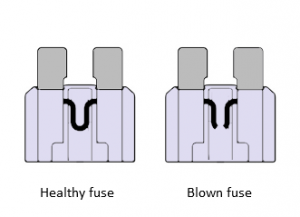About car fuses:
The purpose of a fuse is to protect the wiring in your vehicle. In the event that an electrical component draws too much power or short circuits, the fuse will blow, severing the electrical current and preventing damage to your vehicle’s wiring.
A blown fuse will result in its corresponding component not working until the fuse is replaced. This is due to there being no electrical current reaching the component.
Learn more about how fuses work >
Symptoms of blown car fuses:
- Electrical components not working: Blown fuses can cause electrical components, such as the radio, headlights, power windows, and air conditioning, to stop working. If you notice that one or more of these components are not functioning properly, it could be a sign of a blown fuse.
- Blown-out bulbs: If you notice that a bulb in your car, such as the turn signal or brake light, is not working, it could be due to a blown fuse. The fuse that controls the power to the bulb may have blown, causing it to stop working.
- Engine won’t start: In some cases, a blown fuse can prevent the engine from starting. This is because the fuse controls the power supply to important components, such as the fuel pump or ignition system. If you try to start your car and it won’t turn over, it could be due to a blown fuse.
- Warning lights on the dashboard: If a fuse blows that controls a system that is monitored by your car’s computer, it may trigger a warning light on the dashboard. For example, if the fuse that controls the ABS system blows, the ABS warning light will come on.
Where are the fuses located?
The location of the fuse box can vary between vehicle models, meaning that you should consult your car’s manual / car’s service hand book for owner-specific information.
Common fuse box locations include:
- Under the steering wheel area (often under a pull out cover)
- Inside or under the glovebox
- In the engine compartment
Many cars will have two fuse boxes; one located in the interior of your car and the other located in the engine compartment. The first (interior) fuse box controls components such as the radio, lighting, and wipers whereas the second (engine) fuse controls things such as the engine fans, ABS system and engine computer (ECU).
Checking/replacing car fuses:

Fuses can vary in size, shape, and amperage. This means that some fuses are harder to check and replace than others. In most cases, the most common fuses are shaped like small plugs and are accompanied by a diagram or list that states the purpose of each fuse.
With plug-type fuses, you can check the fuse’s health by looking through the small window located next to the two prongs. If the wire is intact, the fuse is working. However, if the wire has broken or appears burnt, the fuse has blown.
You will need to remove the fuse and replace it with a new fuse with the right amperage level. Fuses are often colour-coded in accordance with their amperage, making it easier for you to find a replacement. For instance a red fuse is normally 10 amps.
Car Fuse Testing and Checking in Hamilton
Has a fuse blown in your car? If so, we can replace it for you.
Sometimes, locating the fuse box and removing fuses can be difficult. For this reason, we offer quick, hassle-free fuse testing and replacements to our customers. When you bring your vehicle in, we will inspect your fuses, determining if a blown fuse is the problem. If so, we can replace it, allowing the fuse’s corresponding component to function normally again.
For new car fuses in Hamilton, contact Grimmer Motors today!

